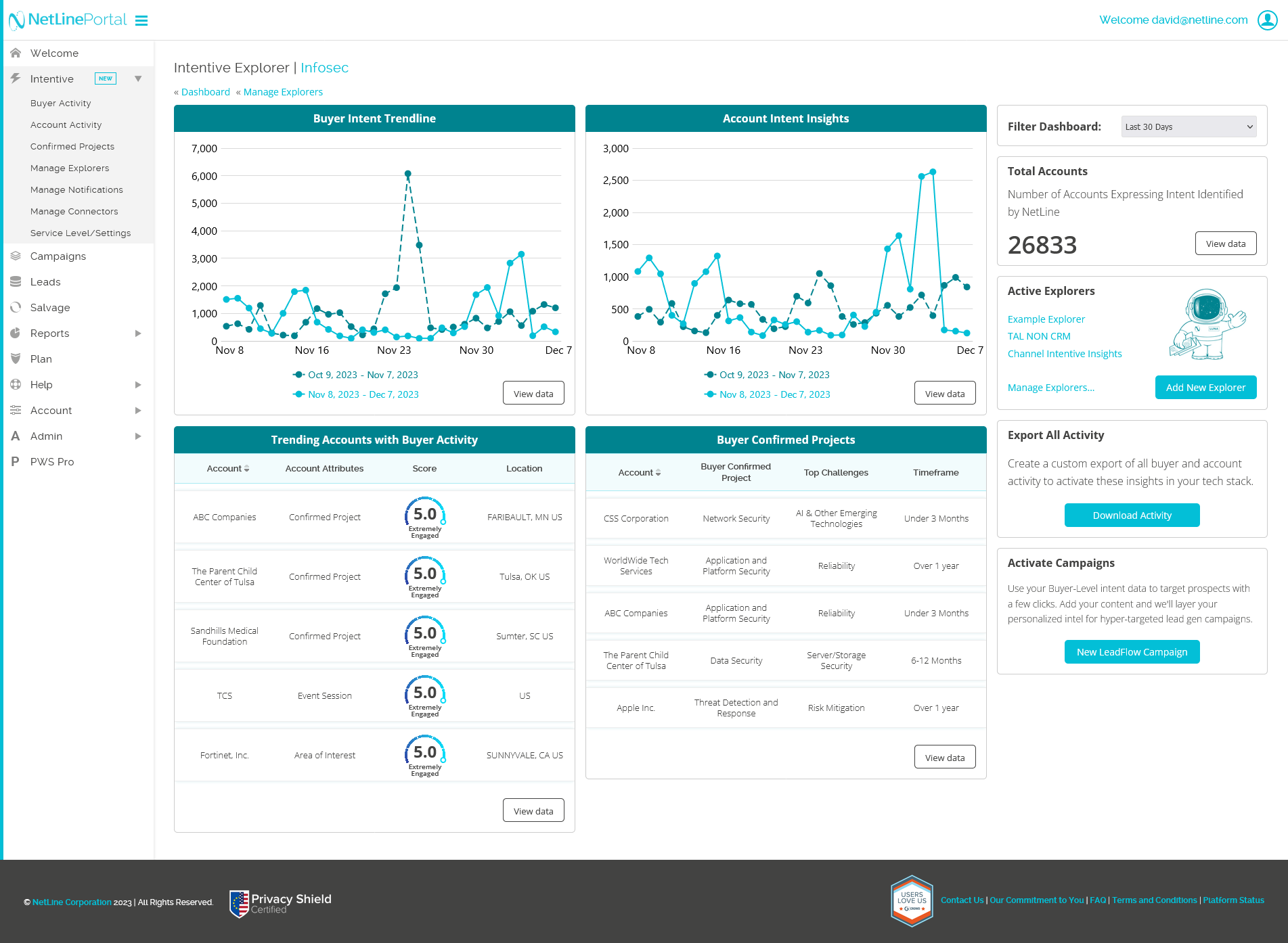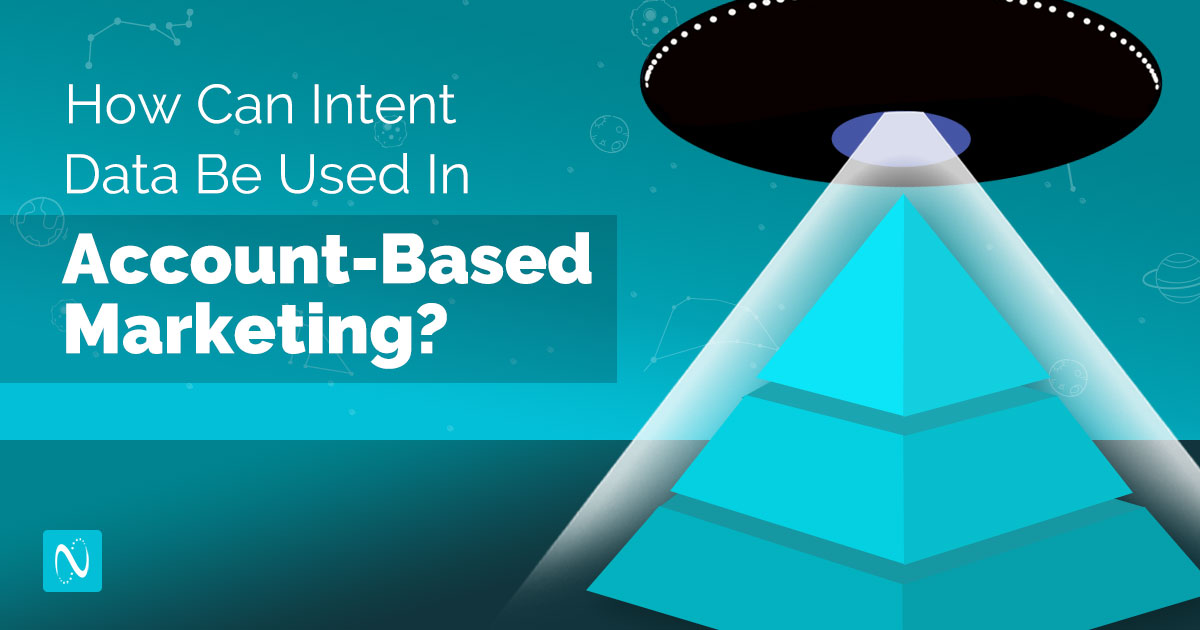It’s no longer enough to broadly target an industry or job title.
Successful B2B marketing requires we understand the specific needs and behaviors of our customers.
While we’ve explored the insights and advantages B2B intent data offers in previous posts, let’s shift our focus to a specific application of this transformative resource: Account-Based Marketing (ABM).

Buyer-level intent data helps you to point out the buyers working at in-market accounts. Made using Midjourney.
Why is intent data critical for effective account-based marketing (ABM)?
Account-based marketing (ABM) has been around for about 20 years, with adoption creeping up throughout that time. Indeed, a recent survey found that nearly two-thirds (63%) of US B2B organizations with annual revenues greater than $50 million are currently using ABM methods and practices.
Support for this strategic approach is strong within organizations that are using it.
The 2022 ABM Benchmark Study from Momentum ITSMA and the ABM Leadership Alliance revealed that 71% of companies planned to increase their ABM spending in 2023, with half increasing their ABM staff this year.
So, where does intent data fit into an account-based strategy? Before we answer this question, let’s take a closer look at what ABM is.
Defining Account-Based Marketing
[Note: those familiar with the ABCs of ABM can feel free to skip this section.]
ABM concentrates resources and efforts on high-value accounts with the greatest potential for conversion and tailors marketing efforts to the specific needs and pain points of these accounts. To put it another way, Gartner offers the following definition:
Account-based marketing (ABM) is a go-to-market strategy targeting certain accounts with a synchronized, continuous set of marketing and sales activities. ABM activities engage those accounts and individuals through all stages of the buying journey.
Even though “marketing” is in the name, Account-Based Marketing (ABM) extends beyond the realm of the marketing department. To successfully execute an ABM strategy, marketing must work closely with sales.
Without alignment between these two departments, your ABM program is destined to fail.
In practice, this means that marketing and sales jointly determine which accounts or account-based criteria to target. The length of your list and your company’s position in the market depends on which type of ABM strategy you intend to use.
Here are the three you have to choose from with a brief explanation of what they are and how they differ:
- One-to-One: This form of ABM targets the least number of accounts (around 15). It demands the greatest investment and places significant emphasis on highly personalized content and experiences. Despite this, the potential return per account can justify the investment, making it vital to focus on high-yield accounts that offer the best returns.
- One-to-Few: The number of targeted accounts swells to about 50 in this approach. Personalization remains crucial, but it doesn’t center on individual accounts. Instead, it focuses on groups of accounts with shared characteristics, such as common pain points or segmentation. Maximizing a one-to-few strategy likely entails increased reliance on marketing automation.
- One-to-Many: This strategy takes ABM to scale, targeting a significantly larger number of accounts compared to the other two types. While investment is lower, so is the return per account. Effective implementation of this type of ABM also demands the use of marketing automation.
The three-stage model has also been described using a pyramid illustration, as shown below:

Image caption: The three types of ABM. Source: ITSMA
Your strategy doesn’t necessarily have to be exclusive to one type of ABM. That previously-mentioned study from Momentum ITSMA revealed that close to half (47%) of respondents were using a combination of at least two types of ABM.
That said, if you’re new to ABM, you might want to start small and scale up from there.
At its core, ABM is about delivering personalized experiences that resonate with the unique needs of each account or account group, and that’s where intent data truly excels.
Imagine being able to access real-time insights into the interests, behaviors, and challenges of both target accounts and the people within those accounts.
That’s what buyer-level intent data provides.
B2B marketers and their colleagues in sales are then able to take that information and identify accounts that are actively seeking their solutions, prioritize them based on their level of intent, and design target campaigns that hit the mark.
This also means that buyer intent data can be used for each of those three types of ABM:
- At the one-to-one level, intent data can be used to provide a white glove sales experience that leaves your buyer feeling valued.
- For one-to-few ABM, there may be an increased amount of personalization through automation, but with a high degree of fine-tuning for each segment.
- Finally, for one-to-many accounts, intent data can be used to deliver relevant campaigns at scale.
Let’s take a deeper dive into how this is done.
How can intent data help B2B marketers identify high-value target accounts?
The first step in a successful ABM strategy is identifying high-value target accounts. Again, the number of accounts on that list will depend on the type of ABM you are using.
Either way, using intent data can ease the way and help you determine the accounts that are likely to convert and when.
According to Demand Gen Reports’ 2021 ABM Benchmark Survey, close to 6 in 10 (57%) of B2B marketers with an ABM strategy were using behavioral/intent signals to help build and formulate their targeted account lists, with another one-third (34%) planning to do so.
The most recent version of the Demand Gen Report survey also indicated B2B organizations with more mature ABM strategies were more likely to use intent/behavioral data (66%) than those just starting on their ABM journey (55%).
By analyzing intent data, you can identify accounts and buyers who are actively researching solutions in your category.
If you’re deploying a one-to-one ABM strategy, you’ll be seeking a limited number of individual accounts. However, with one-to-few or one-to-many ABM approaches, you might aim to identify clusters of accounts with shared pain points or those fitting a specific segment you wish to target.
This proactive strategy not only helps you focus on accounts with the highest conversion potential but can also lead to unexpected discoveries. Keeping a keen eye on intent data when identifying high-value targets could uncover new accounts previously unnoticed.
At this juncture, it’s important to remind you to involve your sales team when selecting high-value accounts to target. As they will be the people interacting directly with buyers, they can offer insights based on their experiences regarding which intent signals to prioritize.
How can intent data inform personalized messaging and outreach strategies for ABM?
One thing that ABM definitely is not is a one-size-fits-all strategy.
Personalized messaging is a cornerstone of ABM, and intent data is the key to unlocking it. Indeed, many marketers who are already using intent data consider personalization as one of the most actionable ways to use intent data.
By analyzing the content that target accounts are consuming, marketers can gain insights into their pain points and interests. Having these insights at your fingertips enables you to tailor messaging and content that will resonate more effectively with your target accounts.
Your target accounts will be delighted to see that your messaging is focusing on the topics and pain points that are most relevant to them and addresses their needs.

NetLine’s INTENTIVE dashboard, showcasing the platform’s ability to highlight first-party activities from buyers and the accounts with which they’re associated.
Buyer-level intent data is especially effective in determining not just what the needs of a target account are but gives you a look at what content individuals within the account are downloading and what they are searching for.
With this information, you can fine-tune your personalization on an individual buyer level.
Personalized messaging and outreach do little if you aren’t reaching your target accounts on the channels they are on. Fortunately, intent data can also identify the most effective channels for outreach.
Whether it’s social media, email, or industry forums, marketers have the opportunity to create campaigns that are more likely to meet their target accounts where they are.
What are the key components of an intent data-driven ABM strategy?
Here’s a rundown of the key elements you will need to drive a successful intent data-driven ABM strategy:
High-quality, buyer-level intent data: Without a doubt, this is the lifeblood of your ABM strategy. Having access to reliable, in-depth intent data provides insights throughout your ABM strategy.
It informs you of the interests, behaviors, and pain points of your target audience so you can build a list that has a higher likelihood of conversion as well as introduce you to accounts that you might not have considered otherwise.
Beyond that, intent data also provides clues on how to create highly personalized messaging and content that will make your targets feel as if you are speaking to them directly. And, when the time comes, intent signals will give sales a heads-up when a target account appears ready to be approached.
Deep understanding of target account needs: Personalization is only effective if it hits the mark. B2B marketers must have a clear understanding of the pain points, interests, and needs of their target accounts to create personalized messaging and content.
Intent data is a conduit for discovering insights into your target accounts so that you can personalize messaging and provide tailor-made content that will guide them through their journey.
A targeted outreach strategy: While personalization is a key component of an ABM strategy, it does little for your target accounts if your messaging and content aren’t on the channels the accounts are using.
Using intent data, you can identify the most effective channels for outreach and create campaigns that are tailored to the specific interests and pain points of your target accounts.
Sales and marketing alignment: Another reminder that while ABM is considered a marketing strategy, it doesn’t work without support and input from sales.
Admittedly, alignment remains a bugbear for many organizations with a survey from the CMO Council showing only 3 in 10 (29%) of marketers saying they are very confident in their current sales and marketing alignment.
Try to think of an ABM strategy driven by intent data as a team sport. Sales and marketing teams must work together to ensure they are targeting the right accounts with the right messaging to get the ball past the goal.
Make the most of intent data in your ABM strategy
The potential of intent data in ABM is boundless. It allows B2B marketers to identify high-value accounts, create personalized messaging that resonates, and develop outreach strategies that are more likely to convert.
Incorporating intent data into your ABM strategy is not just a trend, but a necessity to stay ahead in today’s rapidly evolving B2B marketing landscape. It’s time to transform your approach and adopt a data-driven mindset that will propel your ABM efforts to new heights.
If you’re primed to make the jump and intertwine intent data into your ABM strategy, we’re ready to assist. Reach out to us to learn more about how intent data can invigorate your ABM strategy and drive your business forward.
After all, understanding your customers’ intent isn’t just advantageous—it’s crucial to success.
